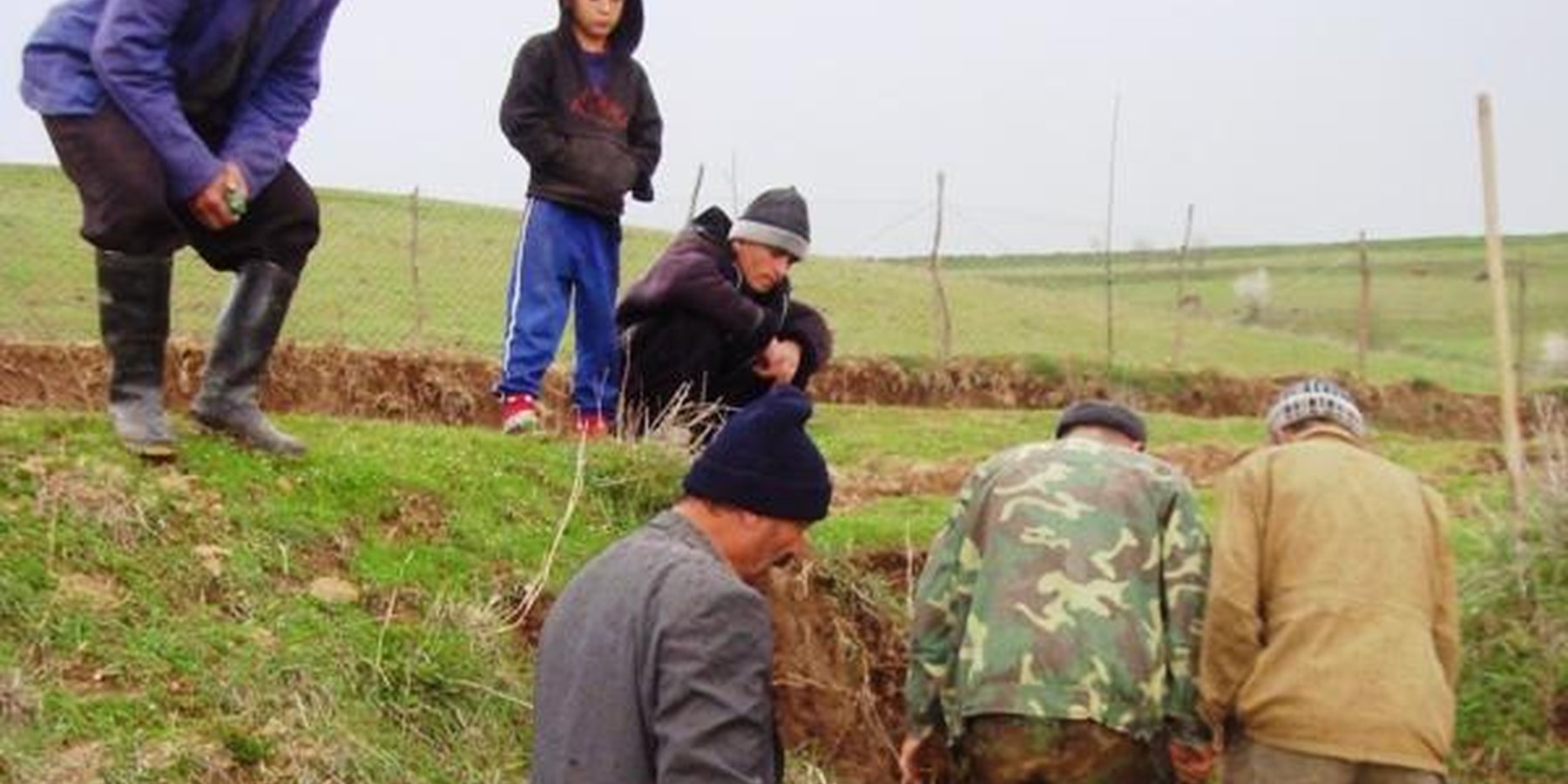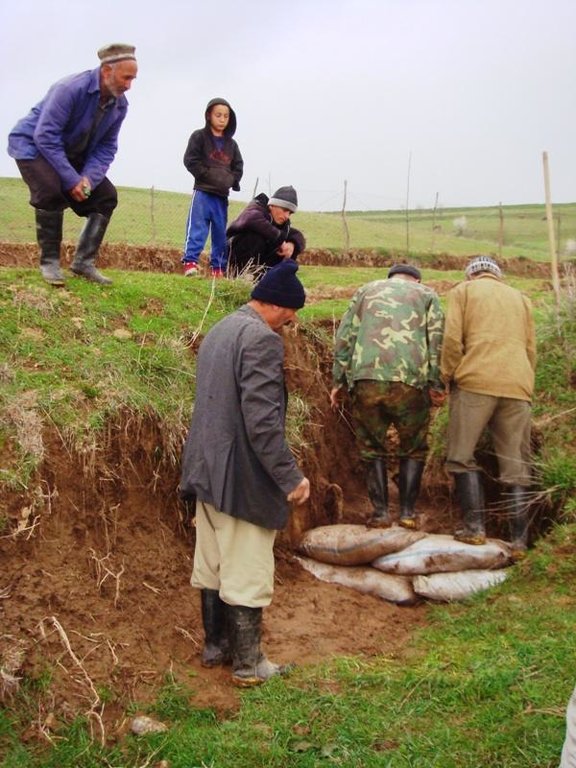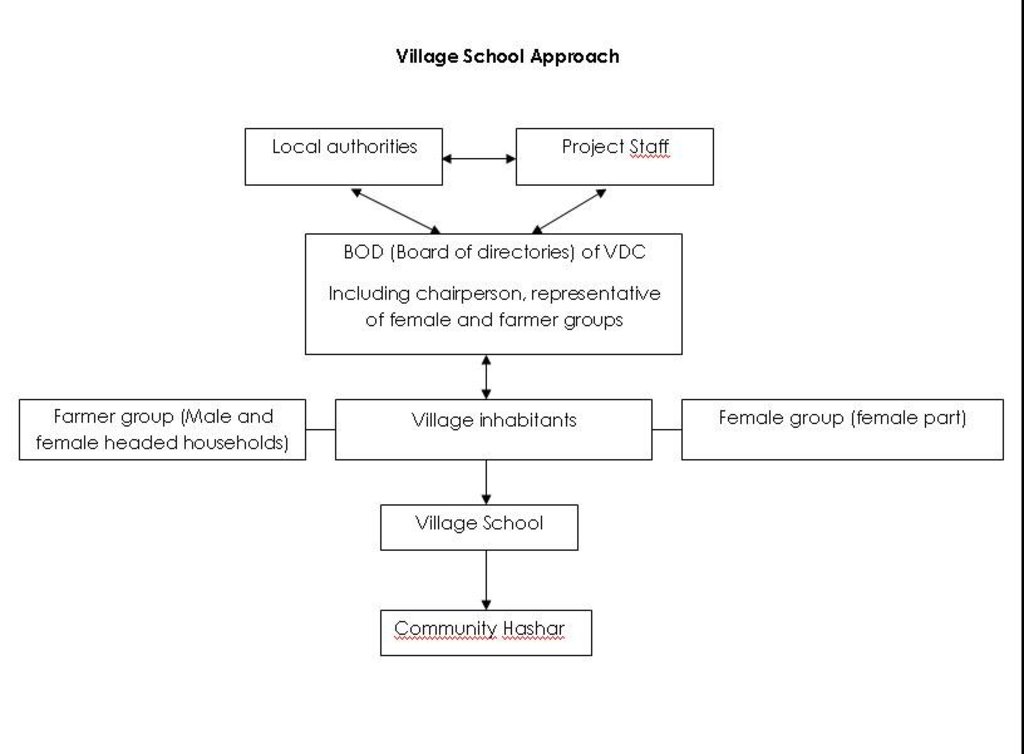Village school participation and involvement [Tadjikistan]
- Création :
- Mise à jour :
- Compilateur : Daler Domullojonov
- Rédacteur : –
- Examinateurs : David Streiff, Alexandra Gavilano
Чалб ва иштироки мактаби деха
approaches_2572 - Tadjikistan
Voir les sections
Développer tout Réduire tout1. Informations générales
1.2 Coordonnées des personnes-ressources et des institutions impliquées dans l'évaluation et la documentation de l'Approche
Nom du ou des institutions qui ont facilité la documentation/ l'évaluation de l'Approche (si pertinent)
Deutsche Welthungerhilfe e. V. (Welthungerhilfe) - Tadjikistan1.3 Conditions relatives à l'utilisation par WOCAT des données documentées
Le compilateur et la(les) personne(s) ressource(s) acceptent les conditions relatives à l'utilisation par WOCAT des données documentées:
Oui
2. Description de l'Approche de GDT
2.1 Courte description de l'Approche
A competitive tendering process for project grant money to implement identified SLM practices within a community, and on completion of the implementation activities the village school will be assigned ownership and responsibility for the maintenance and sustainability.
2.2 Description détaillée de l'Approche
Description détaillée de l'Approche:
Aims / objectives: The objective of the approach is to find a mechanism by which you can involve large sections of the community, allocate land for the communities benefit, provide a mechanism for long term maintenance, and establish a demonstration area for cross site visits and educational training.
Methods: Several methods were employed to implement the approach, these included community and local government workshops, seminars on proposal writing followed by subsequent proposal development in conjunction with local experts and community mobilization. The project staff used the approach to train active community members on suitable land management practices that would benefit identified degraded lands and develop sustainable competitive proposals to be reviewed by a selection panel. The community was encouraged to provide substantial input into the funding of their proposed project if they wanted to be successful. A predetermined condition was set on awarded grants that the degraded land had to be officially allocated to the school for a twenty year period.
Stages of implementation: The INGO Welthungerhilfe announced a competition amongst the local communities in one region to submit project proposals for addressing community environmental problems. The local government were involved from the outset, were encouraged to help suggest communities that should compete. The communities were provided with workshops on how to develop sustainable land management proposals with support from local agronomists. The proposals had to outline the commitment of the community, the area of land to be re-established and how, and finally the level of community contribution towards the project. The terms of the competition dictated that the area of rejuvenated land would be officially signed over to the school for a period of twenty year and the school community would thereby be responsible for the maintenance and upkeep of the land and entitled to invest any profits back into the school, hence indirectly supporting many families in the community. The projects were selected based on a predetermined criterion and the winning projects received part funding in the form of fuel, machinery, fencing etc upto 50% of the final costs. The people were mobilised to implement the project though a community day of action know as a ‘Hashar’ and on completion the school assumed responsibility for the plot of land.
Role of stakeholders: Although the approach is project driven it required buy in from the local authorities, and the heads of collective dehkan farms who dedicate land use right to village schools, however it was the school community that had to be the real driving force to see the proposal developed into a tangible outcome.
2.3 Photos de l'approche
2.5 Pays/ région/ lieux où l'Approche a été appliquée
Pays:
Tadjikistan
Région/ Etat/ Province:
Tajikistan / Khatlon
Autres spécifications du lieu :
Khovaling / Dorobi
Map
×2.6 Dates de début et de fin de l'Approche
Indiquez l'année de démarrage:
2
Date (année) de fin de l'Approche (si l'Approche n'est plus appliquée):
2009
2.7 Type d'Approche
- fondé sur un projet/ programme
2.8 Principaux objectifs de l'Approche
The Approach focused mainly on SLM with other activities (Community initiated SWC activities realised with involvement of village school, holistic approach, )
environmental restoration by community involvement. to prevent soil erosion, gulley expansion and land degradation; to convert barren land to agroforestry system. to create capacity of villagers and young generation to protect environment and effective use of locally available natural resources.
The SLM Approach addressed the following problems: Poor land management practices compounded by a lack of knowledge and funds that have resulted in continued land degradation and loss of fertility.
2.9 Conditions favorisant ou entravant la mise en œuvre de la(des) Technologie(s) appliquée(s) sous l'Approche
disponibilité/ accès aux ressources et services financiers
- entrave
Limited availability of funds
Treatment through the SLM Approach: Project provided support funding to match contributions provided by the community.
cadre juridique (régime foncier, droits d'utilisation des terres et de l'eau)
- favorise
The existing land ownership, land use rights / water rights greatly helped the approach implementation: The state were very supportive of the allocation of land to the schools.
- entrave
There were no formal documented land user rights on the land selected for the implementation of technologies.
Treatment through the SLM Approach: Before the implementation started the plot of land was officially assigned to the school for a period of 20 years.
connaissances sur la GDT, accès aux supports techniques
- entrave
There is a lack of technical knowledge within the community.
Treatment through the SLM Approach: A series of cross visits and practical trainings were organised by the project to neighboring communities.
charge de travail, disponibilité de la main-d'œuvre
- entrave
There is extensive work required in the successful implementation and maintenance of the chosen technologies.
Treatment through the SLM Approach: The plot was divided into 3 parts to assign specific responsibilities.
3. Participation et rôles des parties prenantes impliquées dans l'Approche
3.1 Parties prenantes impliquées dans l'Approche et rôles
- exploitants locaux des terres / communautés locales
Community members and farmers
Mainly heavy activities like organic fertilizers carry, ploughing and planting was carried by males.
Women supported with feeding of workers.
All interested community members were involved in all stages of activities implementation and final beneficiary of action is school.
- Spécialistes de la GDT/ conseillers agricoles
The approach was designed by international experts with input from national specialists
Project technical staff, advisor
- enseignants/ élèves/ étudiants
School teacher
- ONG
WHH project staff
- gouvernement local
Head of jamoat (sub district), and village head
Si plusieurs parties prenantes sont impliquées, indiquez l'organisme chef de file ou l'institution responsable:
local authorities and project staff
3.2 Participation des exploitants locaux des terres/ communautés locales aux différentes phases de l'Approche
| Participation des exploitants locaux des terres/ communautés locales | Spécifiez qui était impliqué et décrivez les activités | |
|---|---|---|
| initiation/ motivation | auto-mobilisation | community members leading by teacher presented project proposal to receive support of project realization to WHH project |
| planification | interactive | teachers together with project staff look through and updated plan |
| mise en œuvre | interactive | in the beginning it was really good and active labor and in-kind contribution of activity, once additionally in cash contribution was required teacher continued alone |
| suivi/ évaluation | soutien extérieur | joint (project staff and villagers) monitoring of activities were realized during activities implementation and finalizing |
| Research | aucun |
3.3 Diagramme/ organigramme (si disponible)
Description:
The organisational set up instigated by the project staff with the involvement of the local authorities resulting in a community day of action for implementation of the technologies
Auteur:
Daler Domullojonov (WHH, Dushanbe)
3.4 Prises de décision pour la sélection de la Technologie/ des Technologies
Indiquez qui a décidé de la sélection de la Technologie/ des Technologies à mettre en œuvre:
- principalement les spécialistes de la GDT, après consultation des exploitants des terres
Expliquez:
The idea was discussed in meeting with villagers, local authorities representatives and project staff.
Decisions on the method of implementing the SLM Technology were made by mainly by SLM specialists with consultation of land users. In the joint meetings low cost measures were chosen and cost sharing discussed with the community members.
4. Soutien technique, renforcement des capacités et gestion des connaissances
4.1 Renforcement des capacités/ formation
Une formation a-t-elle été dispensée aux exploitants des terres/ autres parties prenantes?
Oui
Spécifiez qui a été formé:
- exploitants des terres
- personnels/ conseillers de terrain
Si pertinent, spécifiez le genre, l'âge, le statut, l'ethnie, etc.
To approach provided training on proposal writing and during the technology implementation stage on basic soil c conservation techniques.
Formats de la formation:
- sur le tas
- entre agriculteurs (d'exploitants à exploitants)
- zones de démonstration
- réunions publiques
Thèmes abordés:
Proposal writing, soil conservation techniques and cross site visits.
4.2 Service de conseils
Les exploitants des terres ont-ils accès à un service de conseils?
Oui
Spécifiez si le service de conseils est fourni:
- dans les champs des exploitants?
Décrivez/ commentez:
Advisory service is quite adequate to ensure the continuation of land conservation activities; heads of jamoat (sub district), collective dehkan farm and village
4.3 Renforcement des institutions (développement organisationnel)
Des institutions ont elles été mises en place ou renforcées par le biais de l'Approche?
- non
4.4 Suivi et évaluation
Le suivi et l'évaluation font ils partie de l'Approche? :
Oui
Commentaires:
area treated aspects were regular monitored by project staff through observations; indicators: covered area
no. of land users involved aspects were ad hoc monitored by land users through observations; indicators: progress of used technics
technical aspects were regular monitored by land users through observations; indicators: None
management of Approach aspects were ad hoc monitored by project staff through observations; indicators: None
There were no changes in the Approach as a result of monitoring and evaluation: None
There were few changes in the Technology as a result of monitoring and evaluation: Check dams with plastic sacks were covered after observing short durability, The size of contour trenches were adjusted after rainy season, additionally to rain water harvesting pounds establishment of conservation pound was added upstream
4.5 Recherche
La recherche a-t-elle fait partie intégrante de l’Approche?
Oui
Spécifiez les thèmes:
- technologie
Donnez plus de détails et indiquez qui a mené ces recherches:
Research was carried out on-farm
5. Financement et soutien matériel externe
5.1 Budget annuel de la composante GDT de l'Approche
Si le budget annuel précis n'est pas connu, indiquez une fourchette:
- 2 000-10 000
Commentez (par ex. principales sources de financement/ principaux bailleurs de fonds):
Approach costs were met by the following donors: local community / land user(s) (labour, poles for fence, seedlings of trees and shrubs, seeds of grains, rent of tractor ): 60.0%; international non-government (fencing material, fuel for earth works, part of seedlings, seeds of perennial plants): 40.0%
5.2 Soutiens financiers/ matériels fournis aux exploitants des terres
Les exploitants des terres ont-ils reçu un soutien financier/ matériel pour la mise en œuvre de la Technologie/ des Technologies?
Oui
Si oui, spécifiez le(s) type(s) de soutien, les conditions et les fournisseurs:
In the implementation EC TACIS financed the Welthungerhilfe project support in form of materials and seeds
5.3 Subventions pour des intrants spécifiques (incluant la main d'œuvre)
- intrants agricoles
| Spécifiez les intrants subventionnés | Dans quelle mesure | Spécifiez les subventions |
|---|---|---|
| semences | en partie financé | |
| fertilisants | en partie financé | |
| seedlings | en partie financé | |
- autre
| Autre (spécifiez) | Dans quelle mesure | Spécifiez les subventions |
|---|---|---|
| logistics | intial discussion groups and trainings |
Si la main d'œuvre fournie par les exploitants des terres était un intrant substantiel, elle était:
- volontaire
Commentaires:
The village organised a HASHAR i.e. a community action day.
The initial discussion and training on the development of proposals was partly financed by the community.
5.4 Crédits
Des crédits ont-ils été alloués à travers l'Approche pour les activités de GDT?
Non
6. Analyses d'impact et conclusions
6.1 Impacts de l'Approche
Est-ce que l'Approche a aidé les exploitants des terres à mettre en œuvre et entretenir les Technologies de GDT?
- Non
- Oui, un peu
- Oui, modérément
- Oui, beaucoup
First of all the approach was discussed with all community members.
Est-ce que l'Approche a autonomisé les groupes socialement et économiquement défavorisés?
- Non
- Oui, un peu
- Oui, modérément
- Oui, beaucoup
The project was focused on providing for the communitz schools.
Est-ce que l'Approche a amélioré les questions foncières et des droits d'utilisation qui entravent la mise en œuvre des Technologies?
- Non
- Oui, un peu
- Oui, modérément
- Oui, beaucoup
The problem is unlikely to be overcome in the near future.
Did other land users / projects adopt the Approach?
- Non
- Oui, un peu
- Oui, modérément
- Oui, beaucoup
The approach was implemented in another 15 communities.
Did the Approach lead to improved livelihoods / human well-being?
- Non
- Oui, un peu
- Oui, modérément
- Oui, beaucoup
It was good example of integration low cost soil and water conservation measures to restore existing problems instead of complaining about lack of funds and extra support.
Did the Approach help to alleviate poverty?
- Non
- Oui, un peu
- Oui, modérément
- Oui, beaucoup
non productive land was converted to agro forest, and for the future a well managed orchard can provide substantial support to the school.
6.2 Principale motivation des exploitants des terres pour mettre en œuvre la GDT
- augmenter la rentabilité/ bénéfice, rapport coûts-bénéfices
to convert non profitable land to orchard
- paiements/ subventions
to get support for address environmental problem
- prestige, pression sociale/ cohésion sociale
can be proud of their achievements among other schools
- well-being and livelihoods improvement
to support school
6.3 Durabilité des activités de l'Approche
Les exploitants des terres peuvent-ils poursuivre ce qui a été mis en œuvre par le biais de l'Approche (sans soutien extérieur)?
- incertain
Si non ou incertain, spécifiez et commentez:
The approach was project driven and provided subsidises therefore it may be difficult for the communities to replicate without external sources of finance.
6.4 Points forts/ avantages de l'Approche
| Points forts/ avantages/ possibilités du point de vue de l'exploitant des terres |
|---|
| Additional income source for school budget. (How to sustain/ enhance this strength: Pupils could be taught how to optimise the use of the land.) |
| Improvement in the quality of land and has reduced the risk from natural disasters. (How to sustain/ enhance this strength: The technologies could be adapted as the land improves in the future.) |
| Points forts/ avantages/ possibilités du point de vue du compilateur ou d'une autre personne ressource clé |
|---|
| A major problem was to connect the land tenure with the final beneficiaries within the community. This issue was solved through handing over all rights to village school. (How to sustain/ enhance this strength: The approach may benefit from the involvement of legal land specialist.) |
| It is a low cost, holistic, approach involving all community through village school. (How to sustain/ enhance this strength: It could be further enhanced with extra support of local authorities) |
| The approach provides a source of income for the school and provides a place of learning for the children. (How to sustain/ enhance this strength: Further sites with different SLM practices coul dbe developed into school demonstration plots.) |
6.5 Faiblesses/ inconvénients de l'Approche et moyens de les surmonter
| Faiblesses/ inconvénients/ risques du point de vue de l’exploitant des terres | Comment peuvent-ils être surmontés? |
|---|---|
| It required continuously cultivation activities in the beginning. The community became tired of volunteering after several days. | Responsible person /s has to be in charge to mobilise the people |
| Faiblesses/ inconvénients/ risques du point de vue du compilateur ou d'une autre personne ressource clé | Comment peuvent-ils être surmontés? |
|---|---|
| In the beginning the school did not benefit too much. | Additional crops can be planted |
7. Références et liens
7.1 Méthodes/ sources d'information
- visites de terrain, enquêtes sur le terrain
- interviews/entretiens avec les exploitants des terres
7.2 Références des publications disponibles
Titre, auteur, année, ISBN:
Final narrative report of EC Contract # 144-912
Disponible à partir d'où? Coût?
Welthungerhilfe project in Temurmalik district
Liens et modules
Développer tout Réduire toutLiens
Aucun lien
Modules
Aucun module trouvé





